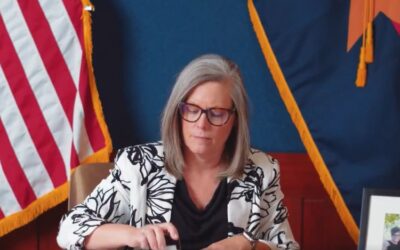By Corinne Murdock |
Last week, the Arizona Board of Regents (ABOR) approved over $2.4 million in salaries and bonuses for all three presidents of the state’s public universities — making them among the highest paid public employees in the state.
Arizona State University (ASU) President Michael Crow received a pay raise of over $38,500, bringing his base salary to over $809,800, as well as a $90,000 bonus. Crow also receives perks: housing, a vehicle allowance, and retirement contributions. ABOR extended his contract through June 2027.
Northern Arizona University (NAU) President José Luis Cruz Rivera received the largest pay raise of $61,800, bringing his base salary to $576,800, as well as a $75,000 bonus. ABOR extended his contract through June 2025.
University of Arizona (UArizona) President Robert Robbins received a pay raise of over $37,700, bringing his base salary to over $792,200. Robbins also received a $75,000 bonus. ABOR extended his contract through June 2025 as well.
The three presidents’ bonuses were contingent on the achievement of various at-risk goals.
Crow met all three at-risk goals: a strategy to address educational gaps in the state, a plan for the launch of at least one of the five Future Science and Technology Centers in the Fulton Schools of Engineering, and clarifying and documenting the expectations for relationships among ASU’s Teaching, Learning, and Knowledge Enterprises.
For Crow, an additional $150,000 in at-risk compensation goals were proposed for next year, each worth $50,000 if met: design and launch a premium brand for ASU online; develop and launch a plan to move the three core brands of the W.P. Carey School of Business, the Fulton Schools of Engineering, and the Barrett Honors College into three global brands; and design and launch a new Health Futures Strategy that includes a holistic approach around health sciences and launch preparations for the Public Health Technology School.
Crow also has five at-risk compensation goals through 2024 worth an additional $160,000. These goals will require Crow to demonstrate increased enrollment and student success in adaptive learning courses by offering over 15 courses, with an increase in overall course completion to over 80 percent; increase enrollment of Arizona students and number of graduates by over 10 percent; complete the design of the Global Futures Library with engagement of over 700 faculty members, as well as merge the three schools of the College of Global Futures; build and document enhanced regional collaboration in research; and demonstrate substantial expansion of ASU Digital Prep to at least 150 in-state schools, predominantly rural and underperforming schools.
Cruz Rivera also had three at-risk goals, which he met: a leadership team for NAU, restructured pricing and financial aid along with marketing and recruiting, and a set of goals and objectives to rebrand NAU.
For the upcoming year, Cruz Rivera has $135,000 in at-risk compensation goals aligned with the rebranding and restructuring efforts at NAU, each worth $45,000. Cruz Rivera must develop and implement a “New NAU System” to encompass in-person, online, and hybrid learning modalities, branch campuses, community college partnerships, and engagement with the state’s K-12 system. Cruz Rivera must also transform NAU Online, as well as increase enrollments and enhance career preparation opportunities.
Through 2024, Cruz Rivera is tasked with $120,000 in at-risk compensation goals, each worth $30,000. Cruz Rivera must expand the number of students from working-class families, increase overall graduation rates, and narrow completion gaps for working-class, first-generation, and minority groups; expand the Allied Health Programs and traditional NAU programs into Maricopa, Pima, and Yuma counties as well as distributed learning centers outside these three counties; and increase NAU profile, visibility, and programs for both Latino and Native American communities throughout the state and nationwide.
Robbins also met his three at-risk goals for this year: a new budget model that reduced college and department overhead costs by at least $10 million, a strategy to raise attainment in southern Arizona, and progress toward creating a Center for Advanced Immunology at the PBC.
In the coming year, Robbins faces $135,000 in at-risk compensation goals: secure at least $200 million in initial funding commitment from the state, local government, or private donors by next June for the Center for Advanced Molecular Immunotherapies; develop a plan to centralize responsibility and balance local authority in the university-wide administrative functional areas of Information Technology and Financial and Business Services by next June; and complete the transition of the UArizona Global Campus as an affiliated partner to its final stage under the full authority and oversight of UArizona by next June.
Then, Robbins faces $120,000 in at-risk compensation goals through the end of 2024: increasing retention by 85.5 percent; leveraging the Washington office of UArizona to increase federal research funding by 10 percent; progressing toward enhancing student experience and outcomes of the UArizona Global Campus; implementing an Information Technology security governance framework; and coordinating a collaborative relationship with ASU and NAU that raises the research potential of the UArizona College of Medicine Phoenix.
Corinne Murdock is a reporter for AZ Free News. Follow her latest on Twitter, or email tips to corinne@azfreenews.com.








